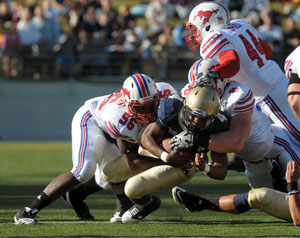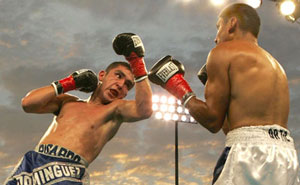
Whether an athlete or an admirer, sports are a staple of American life. Strength, speed, agility, balance, and all the other countless athletic skills necessary in all sporting activities have historically intrigued and brought people together to gaze upon extraordinary athletic ability. From early cave dwellers to the Ancient Greeks’ extremely organized Olympic Games, sports date back as far as the history of humankind. The article, “History of Sports” published by Saperecom, reminds us that many of America’s contemporary sports have their roots in much older tests of athleticism from around the globe. This is illustrated in a series of articles published by Saperecom.
One Saperecom article, “The History of Football,” explains that the belief is that football was derived from rugby and was played by pre-colonial European peasants. The legend is that an Englishman picked up a ball, during the traditional no-hands rugby game, and ran with it.
In another article, “The History of Baseball,” the sport is thought to have begun from the English sport, rounder’s and was renamed baseball in the early 19th century when the sport gained popularity.
Basketball has a unique history. Invented by Dr. James Naismith in 1861 in Ramsay Township in Ontario, Canada, who was a physical education instructor, he wanted to have an indoor sport for students during the long tumultuous Massachusetts winters. Basketball was fashioned from Dr. Naismith’s childhood game of duck-on-a-rock. A game played since medieval European times.
 In the original article, “History of Sports,” we find that many American sports evolved into what we know today during the Industrial Revolution. Public schools insistence of incorporating physical activity into the schools’ curriculum led to milder forms of inherently violent sports. Soccer, rugby, football, and basketball, for example, were altered into less violent forms for the public school children. Dr. Naismith’s basketball invention, along with many other sports traditionally played by adults, was packaged differently for younger groups.
In the original article, “History of Sports,” we find that many American sports evolved into what we know today during the Industrial Revolution. Public schools insistence of incorporating physical activity into the schools’ curriculum led to milder forms of inherently violent sports. Soccer, rugby, football, and basketball, for example, were altered into less violent forms for the public school children. Dr. Naismith’s basketball invention, along with many other sports traditionally played by adults, was packaged differently for younger groups.
As American sports began to resemble today’s sports at the turn of the 19th century, another profound change occurred in the United States, as a variety of races and ethnicities contributed their talents to American sports. Sports allowed these groups, new to the United States, to belong to the new culture even as they struggled with a foreign way of life, and in some groups, a different language. Along with their participation in sports, immigrants trail blazed a path of opportunities for others to follow, an in-road of sorts to assimilating into American society.
During this time in American history, Katherine Benton-Cohen in the article, “The Rude Birth Immigration Reform,” says that immigrants increased the United States foreign population to 14.7 percent. Many of these immigrants were not native English speakers, including Germans, Irish, Italians, Eastern Jews, Slavs, and Japanese. The difficulty of moving from one country to another is challenging especially with distinct cultural changes, but with the additional language barriers, the move is even more trying. In sports, many of the new immigrants found an easier path to integrating into American society because the language of completion crossed all cultural and language barriers.
Baseball is one of the sports known for being a gateway for immigrants. The article, “The History of Ethnic Diversity in Baseball” by Daniel Rhodes, explains that Germans and Irish immigrants embraced baseball as a means to join into American culture because it allowed those from the outside to participate in the American sport.
But sports were not an easy path of acceptance and assimilation for all. The scourge of discrimination was very present. We have only to look more closely at the history of boxing and baseball.
 Boxing in America has a shadowy history. The article, “Beginning of Organized Sports in America," published by Texas State, informs that boxing first became prevalent in the U.S. between slaves during the colonial period. Boxing was a form of entertainment for white Southern landowners as they wagered on their black slaves. White boxers began to rise in number when the prize money increased. As the prize money grew, African-Americans eventually became barred from fighting in heavyweight bouts where the highest amount of money was available. It was not until 1908, when Jack Johnson defeated Tommy Burns to become the first black heavyweight champion of the world that African-American athletes came back to fight professionally.
Boxing in America has a shadowy history. The article, “Beginning of Organized Sports in America," published by Texas State, informs that boxing first became prevalent in the U.S. between slaves during the colonial period. Boxing was a form of entertainment for white Southern landowners as they wagered on their black slaves. White boxers began to rise in number when the prize money increased. As the prize money grew, African-Americans eventually became barred from fighting in heavyweight bouts where the highest amount of money was available. It was not until 1908, when Jack Johnson defeated Tommy Burns to become the first black heavyweight champion of the world that African-American athletes came back to fight professionally.
Other sports continued to ban African-Americans from participating for almost another half-century.
While allowing a diverse group of immigrants, baseball did not allow African-Americans to play professionally until the 1940’s. In the article, “Beginning of Organized Sports in America,” the author notes that Jackie Robinson was the first player to break the color barrier in baseball in 1947, when the then, Brooklyn Dodgers, brought Robinson up through their organization in the National League.
As for basketball, Doug Alden says that Wat Misaka, the son of Japanese immigrants, broke the ethnic barrier in 1947, when the New York Knicks drafted him in the first round.
In 1946, professional football finally opened up when the Los Angeles Rams signed Woody Strode and Kenny Washington, and the Cleveland Browns signed Marion Motley and Bill Willis, all of whom were the first African-American players.
Sports, while not without its challenges, have tended to transcend traditional American society as a trendsetter for the integration of African-Americans and immigrants. Ben Burrows, in the article, “The impact professional sports has on American society,” concludes, “Sports unite America by the simple fact that on game day, your religion doesn’t matter.” Along with religion, sports have shown that ethnicity and race is just as irrelevant. The abilities of an athlete drive the cheers from fans as the spectators look beyond race and ethnicity, and respect the talent these athletes display. Athletes provide spectators with the memory of skills they once had or wished they possessed. The fans live vicariously through the athletes’ profound abilities. This “give and take” relationship is why sports are so important to Americans and the history of America. Acceptance is encouraged as all races and ethnicities join together into one big American community.
Sources
Alden, Doug. Former Utah player broke ethnic basketball barrier.ksl.com September 12, 2008. Retrieved from: http://www.ksl.com/?nid=294&sid=4247755
Beginning of Organized Sports in America. Texas State. 2011. Retrieved from: http://www.hhp.txstate.edu/hper/faculty/pankey/1310/ch17Bread.htm
Benton-Cohen, Katherine. The Rude Birth Immigration Reform. Wilson Quarterly. Vol. 34.
Issue 3. 2010.
Burrows, Ben. The impact professional sports has on American society. Helium. September 19, 2008. Retrieved from: http://www.helium.com/items/1185890-the-impact-professional-sports-have-on-american-society
The History of Baseball. Rennselaer Polytechnic Institute. 2011. Retrieved from: http://homepages.rpi.edu/~fiscap/history_files/history1.htm
History of Football: The Early Years. Saperecom. 2010. Retrieved from: http://www.historyofsports.net/history_of_sports.html
History of Sports. Saperecom. 2010. Retrieved from: http://www.historyofsports.net/history_of_sports.html
Laughead, George Jr. History of Basketball. KansasHeritage.org. January 2005. Retrieved from: http://www.kansasheritage.org/people/naismith.html
Rhodes, Daniel. The History of Ethnic Diversity in Baseball. Livestrong.com. February 7, 2011. Retrieved from: http://www.livestrong.com/article/376244-the-history-of-ethnic-diversity-in-baseball/
Smith, Thomas G. Civil Rights on the Gridiron. The Coffin Corner 10(3). 1988. Retrieved from: http://www.profootballresearchers.org/Coffin_Corner/10-03-336.pdf

Comments
There should not be racism in
There should not be racism in sport. This is suppose to allow an individual to express themselves and escape their problems that they are having. When someone makes a racist remark then it cause the athlete to hate the sport or have hatred for that individual or of the individual descent. Racism is more common in sports today then they were back in the day. People say that basketball is not a predominately African American sport because so many of them play it. Little do these people know that African Americans are only so good because they practice so much to stay out of trouble with the law and not be associated with gang violence.